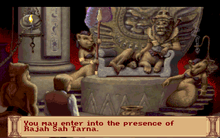Quest for Glory III: Wages of War
| Quest for Glory III: Wages of War | |
|---|---|
 | |
| Developer(s) | Sierra |
| Publisher(s) | Sierra |
| Designer(s) | Corey Cole and Lori Ann Cole |
| Series | Quest for Glory |
| Engine | SCI1.1 |
| Platform(s) | MS-DOS |
| Release date(s) | August 1992 |
| Genre(s) | Adventure/Role-playing video game |
| Mode(s) | Single-player |
| Distribution | 5 Floppy disks |
Quest for Glory III: Wages of War is a hybrid adventure/role-playing video game released in 1992 for MS-DOS. It is the sequel to Quest for Glory II: Trial by Fire.
Quest for Glory II hinted that Ad Avis would return in this installment which was originally titled Quest for Glory III: Shadows of Darkness. However they didn't think they could reach a new audience with a game that was significantly darker in tone then previous games in the Quest for Glory series. Therefore Quest for Glory III: Wages of War was created instead with the game just hinting at the whereabouts of Ad Avis and saving that particular plotline for Shadows of Darkness, which was changed to the fourth in the series.[1]
Plot
Rakeesh the Paladin brings the Hero (and Prince of Shapeir) along with Uhura and her son Simba to his homeland, the town of Tarna in a jungle and savannah country called Fricana that mimics the central African ecosystems.
Tarna is on the brink of war; the Simbani, the tribe of Uhura, are ready to do battle with the Leopardmen. Each enemy has stolen a sacred relic from the other tribe and refused to return it before the other does. The Hero must prevent the war and then thwart a demon who may be loosed upon the world.
The Hero earns membership in the warring tribes, and leads his newfound allies into battle against the demon wizard. As soon as the battle is won, the Hero suddenly disappears into darkness.
Gameplay

Just like the previous installments, this one offers three 'standard' character classes: Warrior, Magic User and Thief. However a 'hidden' class can be opened: a Paladin. In the finale of the previous game a Warrior character who has proved honorable enough is named 'Paladin' by Rakeesh, and can be imported to Quest for Glory III as such.
However, any saved character of any other class can be imported as a Paladin as well, preserving all of his skills acquired in the previous games. Such system allows to create a cross-class characters, so that Paladin for instance can use his own specific abilities along with the spells intended for Magic User without any penalties.
The Magic User character is given the opportunity to create a magical staff. While it is summoned, the player can't move and retain the staff, but the spells don't cost mana points (yet their skills don't raise either).
As for Thieves, the game's reliance on combat and tests of physical strength leave this character underdeveloped in this sequel. Furthermore, Quest for Glory III is the only game in the series to feature only a single place to steal from (Chief Laibon's hut) anywhere nor a Thieves' Guild to fence stolen goods, upgrade skills and equipment.
In a departure from the first two games, Quest for Glory III features an "overworld" screen where all important cities and landmarks are represented in miniature. While traveling from one landmark to another, time passes rapidly, and the player is prone to random encounters, most of which are hostile. The stealthy Thief character is less prone to these encounters. Some random encounters are not hostile, and others are downright silly yet nevertheless helpful in one way or another, such as the Awful Waffle Walker (meant to save the Hero from starvation), and Arne the Aardvark (possible to question for hints).
Each Quest For Glory title usually had a cameo by a comedian or a comedy team: the designers put Sanford and Son in this game, as merchants (i.e., junk dealers) in the Tarna marketplace.
It is also possible to randomly meet Stan Laurel and Oliver Hardy in the savannah, as French Foreign Legion soldiers.
Technical information
Wages of War marked the first game in the series to use the VGA graphics engine which would be used for the next game of the series (the fifth, Dragonfire, utilized 3D graphics). Instead of a text parser interface to control the hero, the use of the mouse to point and click was the main input device. Many diehard fans were disappointed with this change, complaining the game was too "restricting" of its options.
Due to a programming oversight it is impossible to achieve a perfect score in Quest for Glory III. Also, due to an unforeseen glitch early in the game, it's possible to make the game unwinnable if the player misses a key event.
Reception
Computer Gaming World stated that Quest for Glory III "offers perhaps the most exotic and intriguing backdrop" in the series, and praised the "sumptuous" VGA graphics and soundtrack. The magazine concluded that the game "is yet another excellent product from the creative characters at Sierra", and stated that the next game "will be tough to surpass the expectations generated by the excellence already found".[2] In 1993, Dragon gave the game 5 out of 5 stars.[3]
References
- ↑ Rayner, Don (September 8, 2003). "Lori Ann Cole". Adventure Classic Gaming. Retrieved February 1, 2012.
- ↑ James, Jeff (January 1993). "Quest for Glory III". Computer Gaming World. p. 26. Retrieved July 5, 2014.
- ↑ Lesser, Hartley; Lesser, Patricia & Lesser, Kirk (April 1993). "The Role of Computers". Dragon (192): 57–63.
External links
| ||||||||||
| ||||||||||||||||||||||||||||||||||||||||||||||||||||||||||||||||||||||||||||||||||||||||||||||||||||||||||||||||||||||||||||||||||||||||||||||||